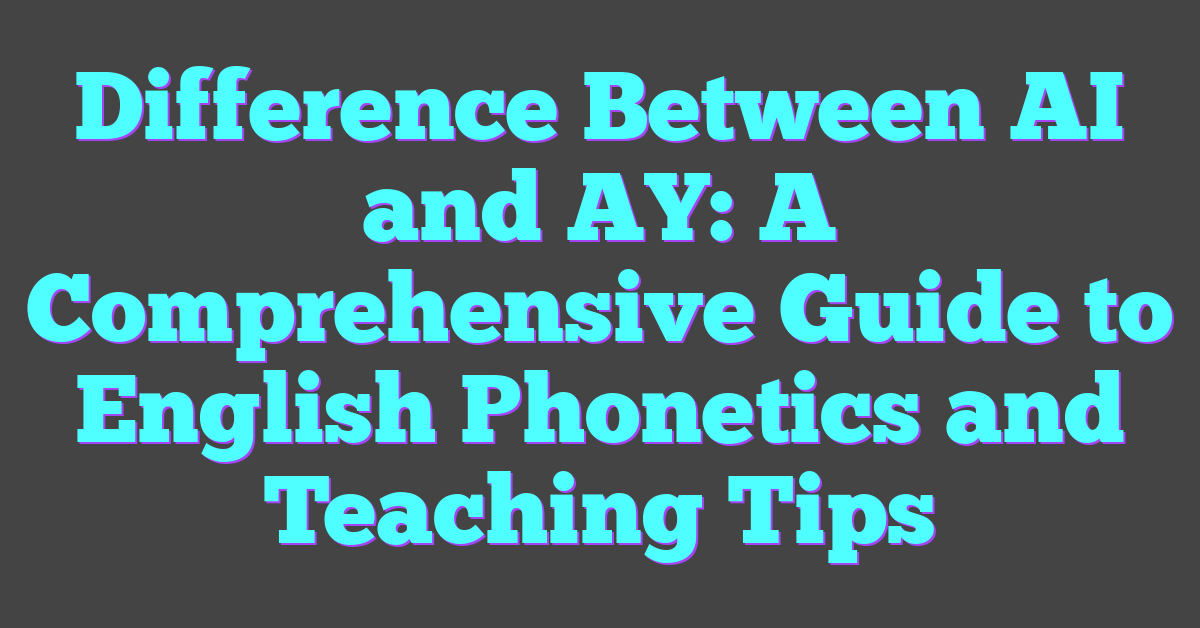Ever wondered why words like “rain” and “ray” sound so similar yet are spelled differently? The difference between “ai” and “ay” might seem subtle, but it plays a crucial role in English spelling and pronunciation. Understanding this difference can help improve both your writing and reading skills.
“AI” and “AY” are vowel combinations that produce distinct sounds and appear in different contexts. While they might seem interchangeable to some, knowing when to use each one can make your English more precise and fluent. Let’s dive into the nuances that set these two apart and clear up any confusion.
Understanding AI and AY Sounds in English Phonetics
Breaking down English phonetic patterns improves both pronunciation and comprehension. Focusing on “AI” and “AY” showcases their unique characteristics.

The Phonetics of AI
“AI” typically produces a single vowel sound, resembling /eɪ/. This diphthong occurs in words like “train,” “rain,” and “plain.” Diphthongs feature two vowel sounds within one syllable, blending smoothly. Mastering “AI” enhances reading and spelling accuracy, revealing how vowel combinations function in diverse words.
The Phonetics of AY
“AY” also creates a single vowel sound, commonly /eɪ/. However, it’s often found at the end of words, such as “gray,” “day,” and “play.” This placement distinction helps differentiate when to use “AI” versus “AY.” Practicing “AY” sound patterns in word-final positions refines phonetic skills, improving verbal fluidity.
Understanding these phonetic intricacies streamlines learning, making English more approachable.
Historical Development of AI and AY
The vowel combinations “AI” and “AY” have deep-rooted histories in the English language, impacting pronunciation and spelling conventions.
Origin of AI in English
The combination “AI” traces back to Old English, Middle English, and partly Latin origins. In Middle English, “AI” began to take shape, often forming words related to visual perception, like “fair” and “plain.” Phonological shifts and influences from Latin and Norman French further evolved its use. The /eɪ/ sound in “AI” is consistently seen in teaching spelling patterns for verbs and nouns.
Origin of AY in English
Symbolizing the end of a syllable or word, the “AY” combination developed through influences from Old French and Middle English. This form began to dominate the end positions of words, signifying adjectives and adverbs like “gay” and “gray.” Its consistency in forming the /eɪ/ sound offers a crucial distinction in English phonetics, particularly for non-native speakers learning vowel sounds.
The historical paths of these vowel combinations have significantly influenced modern English, making their understanding essential for linguistic precision.
Practical Examples of AI and AY in Use
English language learners often encounter various vowel combinations like “AI” and “AY.” Here’s a practical exploration of how these combinations function in everyday words to enhance your understanding.
Common Words with AI
“AI” typically appears in the middle of words, producing a long /eɪ/ sound. Here are some common examples:
- Train: Trains travel across vast distances.
- Rain: The rain falls heavily during the monsoon season.
- Pain: He felt a sharp pain in his arm.
- Main: The main event starts at 7 PM.
- Sail: They sail the boat every weekend.
These examples demonstrate how “AI” integrates into words, often contributing to their root meanings and enhancing comprehension.
Common Words with AY
“AY” usually appears at the end of words, also producing a long /eɪ/ sound. Here are some practical examples:
- Day: Every day brings new opportunities.
- Play: Children play in the park after school.
- Gray: The sky turned gray before the storm.
- Stay: They plan to stay at the hotel for a week.
- Clay: The artist molds clay into beautiful sculptures.
These words illustrate how “AY” often concludes words, maintaining the /eɪ/ sound while signaling the end consonant or syllable.
Using common words with “AI” and “AY” helps learners recognize patterns in English spelling and pronunciation, aiding in both reading and speaking skills.
Teaching Tips for AI and AY Differences
Teaching the differences between “AI” and “AY” can enhance students’ understanding of English phonetics. Each vowel combination’s placement and pronunciation are crucial.
Exercises for AI
To practice the “AI” combination, instructors can present words where “AI” appears in the middle. Students can read these words aloud:
- Train
- Pain
- Rain
After reading, students can write sentences using these words. This practice reinforces the pronunciation and context of “AI.”
Exercises for AY
For “AY,” teachers can provide lists where “AY” appears at the end. Examples include:
- Day
- Stay
- Play
Once students are familiar, they can form sentences with these words. This activity helps learners recognize and pronounce “AY” in different contexts.
By focusing on these exercises, educators help students distinguish and master the differences in vowel sounds.
Conclusion
Understanding the difference between “AI” and “AY” can be a game-changer for students learning English. With the right exercises and teaching strategies, educators can make this learning process engaging and effective. By focusing on pronunciation and context, students will not only improve their reading and spelling skills but also gain confidence in their language abilities. So let’s embrace these tips and help our students master the nuances of English phonetics.
Frequently Asked Questions
What is the main difference between “AI” and “AY” in English phonetics?
“AI” usually appears in the middle of words (like “train” or “pain”), while “AY” typically appears at the end of words (like “day” or “stay”).
Why is it important to teach the differences between “AI” and “AY”?
Understanding the differences helps students improve their pronunciation, reading, and spelling skills, which are vital for mastering English phonetics.
Can you give some examples of words with “AI” and “AY”?
Sure! Examples of “AI” include “rain,” “train,” and “pain.” Examples of “AY” include “day,” “stay,” and “play.”
How can educators help students differentiate between “AI” and “AY”?
Educators can use targeted exercises and activities that highlight each combination’s typical positions within words, reinforcing the correct pronunciation and usage.
What types of exercises can help students practice “AI” and “AY” sounds?
Exercises might include word sorting activities, pronunciation drills, and contextual reading practices that focus specifically on “AI” and “AY” words.
Why do “AI” and “AY” have distinct positions within words?
Their positions influence pronunciation and are a result of English language evolution, making it important for students to recognize and apply these rules correctly.




